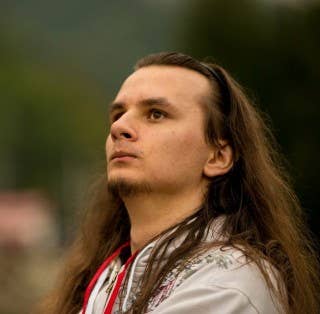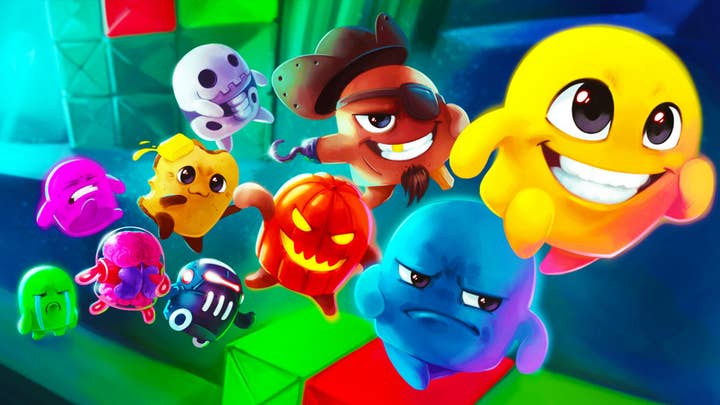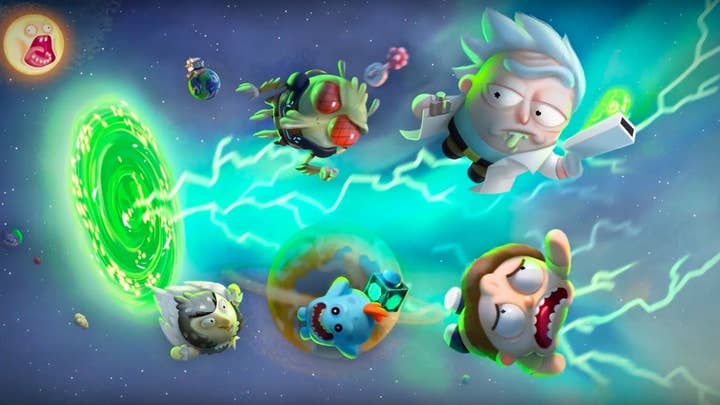"Designing with marketing in mind" in Move or Die
At the Dev Play conference, Nicolae Berbece described taking Move or Die from a humble Flash game to an audience of over 500,000 people
The days when a game's fortunes rested on the few weeks around its launch are long gone. In a digital marketplace, the lasting popularity of a given product is roughly equal to the ingenuity of its creators; if they can generate new methods for attracting new players and keeping an existing community engaged, the sales can keep going for months and even years.
That is very much the case with Move or Die, the "multiplayer, competitive, friendship-ruining party game" from the Romanian indie studio Those Awesome Guys. Speaking at the Dev Play conference in Bucharest earlier this month, the studio's founder, Nicolae Berbece, described Move or Die as "a fairly successful game" - but that's putting it mildly.
Two years after the game officially launched, Berbece said, it had amassed 520,000 players, all of them premium sales at a maximum price of $14.99. Even when promotional discounts and sales of a $40 multiplayer-focused "four-pack" of Move or Die are taken into account, that's a very healthy amount of revenue for a studio that has never been more than five people, three of whom are based in a country that has become a major outsourcing hub in part because of lower costs.
"We made it very clear that this game is not finished... All of our videos [in Early Access} were telling people not to buy the game"
Now consider another stat offered by Berbece earlier in his presentation: after one year on sale, in January 2017, Move or Die had 193,000 players, making its two-year total a 170% increase. Not only did the game continue to pull in new players beyond an already strong first year, it did so at an even greater rate.
The process of putting together his talk was, Berbece said, one of discovery, because even he struggled to articulate exactly why Move or Die has proved to be so successful. The origin of the game can be traced back to a Flash game called Concerned Joe, a single-player puzzle-platformer that Berbece made back in 2011.
"We noticed that lot of players were playing the game over and over again," he said. "It made no sense for a story-based Flash game, which I wasn't very happy with, either. It was kinda laggy. It was mediocre.
"I figured I should make a reimagining of the game; a new version of Concerned Joe, with new graphics, new everything, from scratch."

The team added a Party Mode, which allowed four people to compete through a rapidly cycling series of game types. It was intended to be a separate experience, but it proved so popular among testers that Berbece decided to "to give it its own name, and release it on Steam on its own." According to Berbece, it was supposed to be "a practice run, to see how it feels to release a game. Then we would get back to our main project: Concerned Joe."
That never happened. Before too long, Move or Die's potential was difficult to ignore. By the time it sailed through Steam Greenlight in three weeks in January 2015, doing so would have been foolhardy.
"I was told by other developers that you only get one release," Berbece said. "Your game either explodes during Early Access and you get sales, but when it eventually comes out you get fewer sales; or the opposite, so you keep it low during Early Access to get a big explosion when the game comes out. That's what we went for."
In fact, Those Awesome Guys pursued that second option with unusual vigour and what would become a characteristic honesty. The Early Access version of the game was priced higher than its plans for the full game, in an effort to reduce the number of people who might take a chance on the unfinished version. The fact that it was unfinished was part of the game's home-screen - which came adorned with planned updates and even a progress bar across the bottom - and it was a prominent aspect of all the game's marketing at that time.
"We wanted to keep a mentality of 'fuck paid DLC'... We want to have all of the updates completely free"
Indeed, Berbece showed an early Move or Die trailer in which he, speaking on-screen, explicitly tells the viewer "do not buy it now."
"We made it very clear that this game is not finished," Berbece told the Dev Play audience. "We kept a very low profile, and didn't yell about it a lot... All of our videos [in Early Access] were telling people not to buy the game."
That low-profile still allowed it to surprise people, though, with notable journalists and streamers finding the game at shows like PAX and singing its praises. By the time it officially launched in January 2016, it had enough buzz within the industry to earn a spot on the Steam homepage and garner the four reviews necessary to get a Metacritic rating (a more than respectable 80, in case you're interested), while still being obscure to enough consumers to make a sales "explosion" possible.
A small, controlled explosion did arrive for Move or Die, but despite the time in Early Access to develop the concept and work out the kinks, Berbece wasn't happy. The game still had too many bugs, it was still prone to crashing, and so he set out "four pillars" that he wanted to improve through updates - content, replay value, online gameplay, and marketing - and resolved to disclose the exact number of crashes experienced by its players with each one.
"I wanted to tackle those things and make them better," he said. "The update era started."

One need only look at the update section of the Move or Die website to get a sense of how seriously Those Awesome Guys take that process. Each one is a full branding exercise, the new characters, modes and features they contain complemented by a witty title, a distinct visual identity, and a stylish trailer. In addition, each and every one was released for free - a one-two-three punch of humour, character and honesty that has come to define the way Those Awesome Guys speaks to its audience.
"We wanted to keep a mentality of 'fuck paid DLC'," Berbece said. "Because we hate microtransactions, we want to have all of the updates completely free."
At the end of every trailer for a new Move or Die update, the gravelly-voiced narrator intones "All of this, already in your Steam library, right now". When the need to unify the game's swelling roster of characters, modes and unlocks across different platforms demanded the addition of an in-game store, Those Awesome Guys seized the opportunity to put even more distance between it and the trends evident in so much of the games industry.
"We made an in-game store, but because we have that 'fuck microtransactions' mentality, we called it 'Not a Store' and the in-game currency 'Not Coins'," Berbece said, a point he also made in a video that greeted each and every player the first time they opened Move or Die's Not a Store.
"You'll notice that there are a lot of huge spikes, and all of those spikes were caused by a sale and an update"
"I wanted to encourage players to re-open the game every now and then by pushing free updates, which would also spark the attention of streamers and YouTubers," Berbece said when asked to elaborate on his anti-microtransaction stance. "I just think that we could risk being perceived as 'evil developers' if we made every single character cost 99 cents.
"Personally, I'm not a fan of that, and we decided to stick to it. We probably would have way more money now if we had microtransactions - but we don't, and that's that."
If Berbece is against some of the trends in game monetisation, he nevertheless has a keen eye for how to sell an idea and raise awareness of a product. Those Awesome Guys started using streamers to voice the in-game announcers while it was still in Early Access, and that basic idea - the game acknowledging the world outside of the game, as a means of promoting itself - was pushed even further in Move or Die's pivotal "Viewers Versus Streamers" update.
That update got its title from a headline feature that allows viewers to influence the game as a streamer plays; voting on a switch in game modes, for example, or trying to kill their character by firing lasers or dropping bombs. It gave rise to marketing events that delighted both parties, while feeling entirely organic to the game's community.
Viewers Versus Streamers also saw the first example of Move or Die adding a core mechanic from another game; in this case it was Terri Vellmann's Heavy Bullets, but Those Awesome Guys went on to incorporate mechanics from Terry Cavanagh's VVVVVV and Superhot Team's Superhot - always with permission from the creator of the game, Berbece was careful to add.
This idea of referencing the larger industry within Move of Die was also applied to its character roster, with avatars based on the logos from Newgrounds and Twitch. Berbece was so taken with the idea that he was emboldened to approach Justin Roiland about using the main characters from his hit TV show, Rick & Morty. At the end of 2016, he finally got a response. Roiland said yes.

"That was fucking awesome," he said. "We did it, and in June, in the middle of the Steam Summer Sale, the Rick and Morty update came out. I later realised that Adult Swim was doing this with other games as well; apparently [Rick and Morty] had cameos in Rocket League, in Gang Beasts, but we were the one that actually had a trailer. Whenever the press picked up the story, our trailer was the first and we got a lot of coverage because of that - a lot of coverage."
Each of these examples is an expression of Berbece's belief in "designing with marketing in mind", reinforcing the game as a commercial and creative entity with the same stroke.
"Whenever I come up with an idea for the game, I immediately think about how the trailer would look or how we can sell the idea," he said, and the success of that approach can be seen in the thousands of Very Positive Steam user reviews for Move or Die, and also the graph Berbece showed charting its sales since the Early Access launch to the day of the presentation - a steadily climbing line punctuated by tall spikes.
"You'll notice that there are a lot of huge spikes, and all of those spikes were caused by a sale and an update," he said. "A lot of people ask me why Move or Die was successful, and I still don't have a proper answer for that. So I tried to ask the players, why did you buy the game? Why do you think Move or Die was successful?"
The deluge of comments that poured in touched on a host of different areas: specific mechanics, the participation of a favourite streamer, flashes of humour in the game's animations and visual flourishes.
"There were a lot of different reasons, but one reason was echoed in a lot of comments, and that was, basically, us - the developers," Berbece said. "Because of how we treated our players, because of how we cared about our updates, because of the whole no microtransactions thing.
"Throughout this whole journey, with all the updates and comments and my experiences, I reached a conclusion: we should all aspire to be the kind of developers that we would personally support as gamers."
